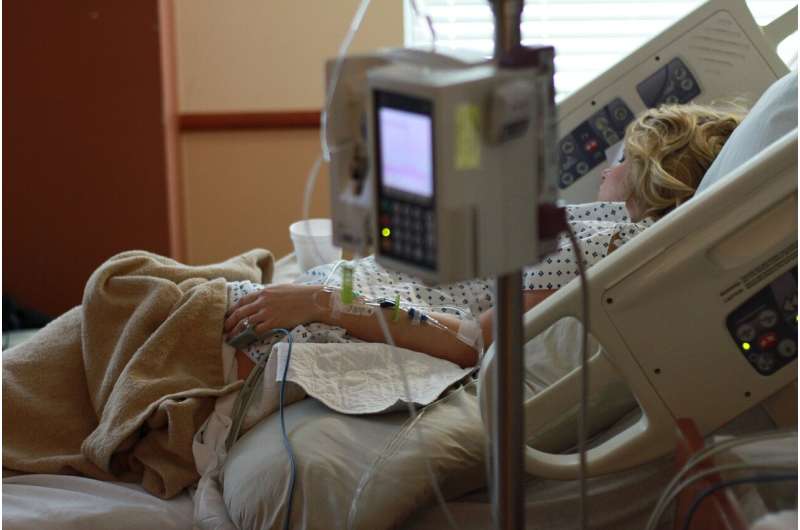Could artificial intelligence prevent sepsis in hospital patients? Sentara thinks so.

During your stay in a hospital, computer systems are collecting and analyzing all sorts of data about you.
In the background of all the beeping and gadgetry, an electronic medical record contains thousands of bits of information about your medical history, vital signs and laboratory results.
Sentara Healthcare is now deploying artificial intelligence to use that data to stop patients from contracting life-threatening sepsis. Earlier this year the system launched a sepsis prediction tool that alerts doctors and nurses when a patient is at risk of developing the deadly infection.
The tool "looks at relationships in order to predict what might happen in the future," said Dr. David Mohr, Sentara's vice president of clinical informatics and transformation.
Sepsis kills about a third of all patients who die in a U.S. hospital. It happens when a severe infection develops somewhere in the body—often by bacteria, or a fungal pathogen—and gets out of control, prompting a toxic response. The immune system can turn on itself.
Sepsis is common and therefore "something that most physicians who work in a hospital are familiar with," said Dr. Michael Hooper, vice president of medical affairs at Sentara Norfolk General Hospital. "But despite that familiarity, it can be somewhat hard to detect. And that can sometimes lead to delays in diagnosis, which have been shown over and over again to severely impact the outcome of the patient."
Unlike other conditions that lab work might present telltale symptoms, septic patients can show a series of physiological or changes "that require a physician to put together the pattern and recognize that this could be sepsis," Hooper said.
And sepsis acquired during a hospital stay is deadlier than sepsis obtained elsewhere. For example, nearly a third of patients who acquired sepsis at a Sentara hospital died in the first half of this year, according to hospital data, as opposed to a 9.5% mortality rate among the hospital system's total sepsis cases. That's likely because hospital patients are sicker in general, Hooper said.
The new AI tool grabs about 4,500 pieces of data about a patient that live in the electronic record—body temperature, heart rate, blood tests, past medical history, gender, where they live and so on—and runs it all through an algorithm that assesses risk for developing sepsis.
If a patient is deemed high risk, the tool spits out an alert that notifies a doctor or nurse the next time they open the medical chart. The alert also links to clinical guidance to help the provider determine what to do next.
Possible interventions include putting the patient in different physical positions to prevent aspiration, cleaning bronchial pathways to prevent pneumonia, monitoring vital signs more frequently or moving a patient to an isolated area with lower risk of picking up germs from the environment, Mohr said.
Meanwhile, Hooper and other local doctors are also part of a clinical trial, watched closely internationally, researching whether a simple Vitamin C cocktail is an effective treatment for sepsis.
Sentara had already developed what it called a "sepsis sniffer" to detect when a patient was "just starting to have sepsis," Mohr said. That system used nine data points. The new one, partnered with the analytics company Jvion, "goes way beyond" the sniffer and does not wait until a patient has already developed the disease.
The health system isn't the first to roll out such a tool. North Carolina's Duke University, for example, last year launched what it calls Sepsis Watch, a similar AI system that identifies potential sepsis cases and alerts clinicians. Hospitals in Alabama and Baltimore have also joined the trend, with varying degrees of success.
Back in 2016, the Hospital of the University of Pennsylvania put a similar system in place but shut it off within a year in part because it identified patients who medical staff were already watching, according to the Institute of Electrical and Electronics Engineers' magazine.
Hooper said the tool has gotten mixed feedback from doctors so far. Many have recognized the benefit when an alert brought their attention to a patient who might've been at risk. Others, already bombarded with pages and alerts and computer work, see it as another interruption identifying patients who may already be on their radar.
Hooper still makes rounds in the intensive care unit, and has seen the alert pop up. For some patients it was helpful, for others it didn't seem applicable.
Screening tools are not designed to be perfect, he said, but to help physicians "not to miss things." That's where artificial intelligence can fill a gap.
"There's thousands of data points generated every day on patients in (the hospital) environment," he said. "Missing single data points can lead to patient errors. Making single inappropriate decisions can lead to true harm. And anytime you have a human being trying to process all that information on an entire ICU full of patients, making all those decisions, there's an opportunity for error."
Sepsis cases have been increasing gradually over the years, Hooper said, "as our population's gotten older and we've gotten better at managing chronic illness" and keeping people alive.
It's too early to tell if the new algorithm is having a statistically significant effect, and it will also always be difficult to draw a direct connection between any positive results and a tool whose very design is to stop cases before they show up as statistics at all, he said. But overall, the number of cases is trending downward.
©2019 The Virginian-Pilot (Norfolk, Va.)
Distributed by Tribune Content Agency, LLC.















